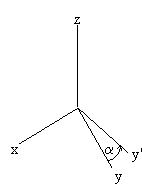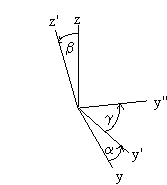

Vectors in the subspace E(j1,j2) may be expanded in terms of ![]() or
or ![]() basis vectors.
The
basis vectors of one basis can be written as linear combinations of basis vectors of the
other basis.
basis vectors.
The
basis vectors of one basis can be written as linear combinations of basis vectors of the
other basis.
![]()
![]() .
.
The expansion coefficients ![]() are
called the Clebsch-Gordan coefficients. Sometimes the Clebsch-Gordan coefficients are
written in terms of the Wigner 3-j symbols.
We have
are
called the Clebsch-Gordan coefficients. Sometimes the Clebsch-Gordan coefficients are
written in terms of the Wigner 3-j symbols.
We have
![]()
Properties of the Wigner 3-j symbols:
![]()
We can permute the columns of the 3-j symbol. An even permutation does not alter its
value. An odd permutation multiplies the initial value by ![]() .
Moreover,
.
Moreover,
![]() .
.
This implies
![]()
or
![]()
When adding the angular momenta j1, j2, and j3, many different states of the system may correspond to the same value of j and m.
![]()
Let ![]()
Then
![]()
The Racah W coefficients and 6-j symbols transform from one scheme of adding three angular momenta to another.
The 9-j symbols transform from one scheme of adding four angular momenta to another.
Links:
We will now establish a connection between the Clebsch-Gordan coefficients and the matrix elements of operators that transform like the spherical harmonics under rotation.
Angular momentum and rotations are closely linked. Let us, for a moment, return to the rotation matrices. An arbitrary rotation can be accomplished in three steps, known as Euler rotations, and it is therefore characterized by three angles, known as Euler angles. We may proceed as follows.
First rotate the body ccw about the z-axis by an angle a. Then rotate ccw about the y’-axis by an angle b. Finally rotate ccw about the z’-axis by an angle g.



The rotation matrix is R(a,b,g)=Rz’(g)Ry’(b)Rz(a). (Note: In quantum mechanics it is advantageous to perform the second rotation about the y’-axis. In classical mechanics the second rotation is often performed about the x’-axis.) Rz’(g) and Ry’(b) are rotations about body-fixed axis. We want to express these rotations in terms of rotations about space-fixed axis. We may write Ry’(b)=Rz(a)Ry(b)Rz-1(a). Similarly, Rz’(g)=Ry’(b)Rz(g)Ry’-1(b). We can now rewrite R(a,b,g) as
R(a,b,g)=Rz’(g)Ry’(b)Rz(a).
=Ry’(b)Rz(g)Ry’-1(b)Ry’(b)Rz(a)
=Ry’(b)Rz(g)Rz(a)
=Rz(a)Ry(b)Rz-1(a)Rz(g)Rz(a)
=Rz(a)Ry(b)Rz(g).
Rotations
about the same axis commute.)
The rotation operator U(R(a,b,g)) therefore may be written as
U(R(a,b,g))=U(Rz(a))U(Ry(b))U(Rz(g)).
It only involves rotations about space-fixed axis. We already know the rotation operators for rotations about space-fixed axes. (See notes.)
For a spin ½ particle U(R(a,b,g))=U(Rz(a))U(Ry(b))U(Rz(g)) becomes
![]()

using

 .
.
The matrix elements of the second rotation are purely real. This is a result of choosing the y’-axis for our second Euler rotation.
For a system with angular momentum J the matrix elements of the rotation operator in the subspace E(j) in the {|j,m>} basis for a rotation R(n,q) are
Uj m',m(R)=<j,m'|exp(-iJ×nq/h)|j,m>.
In E matrix elements between states with different values j vanish. In E the matrix of the rotation operator is block diagonal. Uj(R) is referred to as the (2j+1)-dimensional irreducible representation of the rotation operator U(R). The Uj(R) form a group.
The matrix elements of the rotation operator, ![]() for the rotation R(a,b,g) are
for the rotation R(a,b,g) are
![]()
![]()
The only part which mixes different m values is the middle rotation. We can define a new matrix dj with elements
![]() ,
,
which contains the nontrivial part of the rotation matrix Uj(a,b,g) .
The matrix elements ![]() are also listed on the standard table of Clebsch-Gordan
coefficients.
are also listed on the standard table of Clebsch-Gordan
coefficients.
We can establish a connection between the rotation operator and the spherical harmonics
by constructing the state vector ![]() ( This state vector is an eigenvector of
the position operator.)
( This state vector is an eigenvector of
the position operator.)
Let ![]() and
and ![]() Then
Then
![]()
and
![]()
(Matrix elements between states with different values l vanish.)
We have
![]()
We therefore have
![]()
or
![]()
This is the connection between the rotation operator and the spherical harmonics.
When m
= 0 then ![]()
How do the spherical harmonics transform under rotation?
Let ![]()
Then ![]()
![]()
But ![]() ,
therefore
,
therefore ![]()
The function ![]() can also be viewed as
an operator in coordinate space. (It could, for example, be the operator of an experiment
that measures an emission pattern and projects it onto a known distribution.)
The coordinate representation of this operator operating on the state vector |y>
is
can also be viewed as
an operator in coordinate space. (It could, for example, be the operator of an experiment
that measures an emission pattern and projects it onto a known distribution.)
The coordinate representation of this operator operating on the state vector |y>
is ![]() y(r),
just as the coordinate representation of the operator X operating on the state
vector |y> is xy(r).
y(r),
just as the coordinate representation of the operator X operating on the state
vector |y> is xy(r).
Rotating the observable ![]() we obtain
we obtain
![]() . (See notes.)
. (See notes.)
[U(R)|r>=|Rr>, U(R)y(r)=y(R-1r), UT(R)y(r)=y(Rr),
UT(R)Ylm(n)y(r)=Ylm(Rn)y(Rr),
UT(R)Ylm(n)U(R)y(r)=UT(R)Ylm(n)y(R-1r)=Ylm(Rn)y(r)=Ylm(n')y(r)]
We may therefore write
![]()
We define as an irreducible tensor operator of rank k any set of 2k+1 quantities that transform like the spherical harmonics Ykq under rotation.
Tkq is an irreducible or spherical tensor of rank k with 2k+1 components if
![]()
or, equivalently
![]()
or
![]()
Considering the infinitesimal form of this expression we have
![]()
or, multiplying out the terms,
![]()
This yields
![]() .
.
The two commutation relations can also be taken as a definition of a spherical tensor of rank k.
Examples of tensor operators:
![]()
Using our definition of a vector operator ![]() we can show that these components satisfy the commutation relations that
define a spherical tensor of rank 1. For example,
we can show that these components satisfy the commutation relations that
define a spherical tensor of rank 1. For example, ![]()
![]() etc.
etc.
A vector operator therefore is a spherical tensor operator of rank 1.
![]()
![]() is a scalar,
is a scalar, ![]() represents three independent components
which transform like a vector.
represents three independent components
which transform like a vector.
![]() represents the components of a traceless, symmetric tensor with 5 independent components.
Tij
has been decomposed into three objects that transform like the spherical harmonics with l
= 0, 1, and 2 respectively. It has been decomposed into irreducible spherical tensors.
represents the components of a traceless, symmetric tensor with 5 independent components.
Tij
has been decomposed into three objects that transform like the spherical harmonics with l
= 0, 1, and 2 respectively. It has been decomposed into irreducible spherical tensors.
Why do we care about tensor operators?
The matrix elements of tensor operators with respect to angular momentum eigenstates satisfy
![]()
![]()
The double bar matrix element is independent of m, m’, and q.
This
is the Wigner-Eckart theorem.
(In the above equation (2j'+1)-1/2 is factored out of the
double bar
matrix element. This factoring is not unique. Different books may factor out a different
factor.)
The matrix element ![]() is written
as the product of two factors. The first factor is a Clebsch-Gordan coefficient which
depends only on the way the system is oriented with respect to the z-axis.
It does
not depend on the physical nature of the particular tensor operator. The second term
depends on the physical nature of the operator and the system, but it does not depend on
the magnetic quantum numbers m, m’, and q. To evaluate
is written
as the product of two factors. The first factor is a Clebsch-Gordan coefficient which
depends only on the way the system is oriented with respect to the z-axis.
It does
not depend on the physical nature of the particular tensor operator. The second term
depends on the physical nature of the operator and the system, but it does not depend on
the magnetic quantum numbers m, m’, and q. To evaluate ![]() for the various combinations of m,
m’, and q we need to only evaluate one matrix element. The others are
related via the Clebsch-Gordan coefficients.
for the various combinations of m,
m’, and q we need to only evaluate one matrix element. The others are
related via the Clebsch-Gordan coefficients.
Certain selection rules for tensor operators follow directly from the selection rule of
the Clebsch-Gordan coefficients. The matrix element ![]() is zero unless m’=m+q and
is zero unless m’=m+q and ![]()
Proof of the Wigner-Eckart theorem:
Using the commutation relations that define a tensor operator we have
![]()
yields
![]()
![]()
or
![]()
![]()
![]()
We find the same recursion relations for the ![]() as we found for the Clebsch-Gordan
coefficients with j1=j, j2=k, and j=j’, m1=m,
m2=q, and m=m’ . Therefore the m behavior of the
as we found for the Clebsch-Gordan
coefficients with j1=j, j2=k, and j=j’, m1=m,
m2=q, and m=m’ . Therefore the m behavior of the ![]() must be the same as that of the
Clebsch-Gordan coefficients. We write
must be the same as that of the
Clebsch-Gordan coefficients. We write
![]()